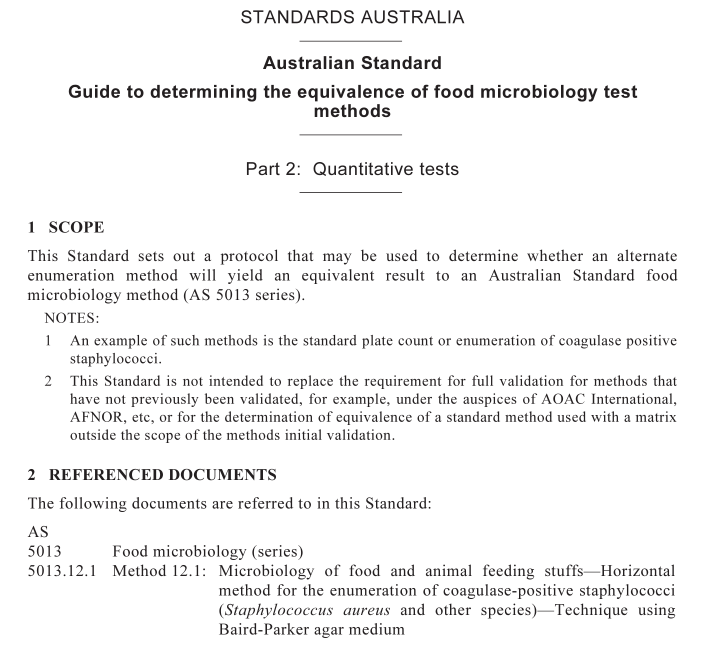AS 4659.2 pdf download – Guide to determining the equivalence of food microbiology test methods Part 2: Quantitative tests

AS 4659.2 pdf download – Guide to determining the equivalence of food microbiology test methods Part 2: Quantitative tests
3.7 Target organism The genus, species, antigenically, toxicologically or physiologically defined group of organisms which the reference method is designed to detect.
4 PROCEDURE
4.1 Define the equivalence determination The equivalence determination should be defined in terms of the following: (a) The target organism’s genus, species, serotype, etc.
(b) The matrix under examination; the food and the characteristics that define it—the matrix should be defined in terms of characteristics such as pH, solids level, season of production, brand name, water activity, presence and composition of preservatives etc. depending upon the nature of the matrix. NOTE: When determining equivalence of an alternate method the laboratory should select the matrices to be included in the evaluation from those within the scope of the standard method. This Standard is not intended for the validation of matrices outside of the scope of either the alternate method or the standard method. Reference should be made to standard texts and the literature to support the choices of matrices. The choice should take into account the range of samples tested by the laboratory and the effects that the natural variation in significant parameters may have on the detection of the target organism.
(c) The alternate method—precisely defined by reference to a publication, manufacturer’s instructions and any optional procedures employed or deviation from the published method.
(d) The reference method—including the specification of any optional steps. For example, the validation of the use of XYZ agar as an alternative to Baird Parker agar in the AS 5013.12.1 method for the enumeration of coagulase positive staphylococci, from custards containing spices and flavours and a pH greater than 4.5.
(e) Steps of methods which are to be compared, for example, the alternate method may completely replace the reference method or only a section of the reference method.
(f) The range of colony forming units for which the alternate method is deemed equivalent.
4.2 Define the conditions of the equivalence determination The conditions of the equivalence determination should be defined in terms of the following:
(a) The laboratory where testing is performed.
(b) Controls observed by the laboratory during testing, for example controls on the environment of the laboratory, prevention of cross contamination, controls on media and reagents, calibration of equipment, etc. where these factors are considered critical to the success of either method.
(c) The staff performing the tests (experience, qualifications, etc.).
(d) The starting and finishing dates of the tests.
(e) The batch numbers of media, reagents, etc. used. NOTE: This information is defined for the purpose of reporting on the equivalence determination and recording factors which may have some bearing on the results obtained. These factors do not necessarily affect the veracity of the study or its applicability in other laboratories.
4.3 Select test organisms
4.3.1 For non-selective methods All samples should be naturally contaminated samples.
4.3.2 For selective quantitative methods A minimum of five strains of the target organism should be selected. The reference culture prescribed as a positive control should be one of the five strains. The other strains may be selected from the following list (in order of preference):
(a) Strains of the target organism isolated by the laboratory from previous samples of the matrix under examination.
(b) Strains of the target organism isolated by reference laboratories or industry sources as representative of the strains found in the type of matrix under examination.
(c) Strains of the target organism traceable to culture collections.
NOTE: Commercial preparations of known concentrations may be used. The strains selected should encompass the variation that may be expected to be found within the target organism in the matrix under examination. The identity of the strains chosen should be determined by appropriate means (e.g. biochemical, physiological, serological, molecular) before performing further work. Consultation with a reference laboratory or an expert may be necessary. The source and identity of the strains should be recorded. NOTE: It is possible, by the selection of test strains, to bias the results of the study. Care should be taken to select representative strains which do not possess characteristics which are likely to lead to a biased result being obtained.
4.4 Select samples of the matrix Five typical samples of the matrix should be selected. They should represent as far as possible the range of variation found within the defined matrix. The choice of samples will depend upon the matrix, but may consist of batches with high or low background contamination, samples with different pH values, fat, protein or moisture levels. The aim of the selection is to choose samples which will represent the range of variation expected to be found in the defined matrix. Care should be taken to select samples with characteristics which are expected to yield homogeneous results in the test being validated. Naturally contaminated samples, if available, should be used instead of artificially contaminated samples. Care should be taken to determine the identity, level and homogeneity of contamination.









